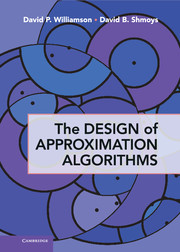Book contents
- Frontmatter
- Contents
- Preface
- I An Introduction to the Techniques
- 1 An Introduction to Approximation Algorithms
- 2 Greedy Algorithms and Local Search
- 3 Rounding Data and Dynamic Programming
- 4 Deterministic Rounding of Linear Programs
- 5 Random Sampling and Randomized Rounding of Linear Programs
- 6 Randomized Rounding of Semidefinite Programs
- 7 The Primal-Dual Method
- 8 Cuts and Metrics
- II Further Uses of the Techniques
- Appendix A Linear Programming
- Appendix B NP-Completeness
- Bibliography
- Author Index
- Subject Index
6 - Randomized Rounding of Semidefinite Programs
from I - An Introduction to the Techniques
Published online by Cambridge University Press: 05 June 2012
- Frontmatter
- Contents
- Preface
- I An Introduction to the Techniques
- 1 An Introduction to Approximation Algorithms
- 2 Greedy Algorithms and Local Search
- 3 Rounding Data and Dynamic Programming
- 4 Deterministic Rounding of Linear Programs
- 5 Random Sampling and Randomized Rounding of Linear Programs
- 6 Randomized Rounding of Semidefinite Programs
- 7 The Primal-Dual Method
- 8 Cuts and Metrics
- II Further Uses of the Techniques
- Appendix A Linear Programming
- Appendix B NP-Completeness
- Bibliography
- Author Index
- Subject Index
Summary
We now turn to a new tool that gives substantially improved performance guarantees for some problems. So far we have used linear programming relaxations to design and analyze various approximation algorithms. In this section, we show how nonlinear programming relaxations can give us better algorithms than we know how to obtain via linear programming; in particular we use a type of nonlinear program called a semidefinite program. Part of the power of semidefinite programming is that semidefinite programs can be solved in polynomial time.
We begin with a brief overview of semidefinite programming. Throughout the chapter we assume some basic knowledge of vectors and linear algebra; see the notes at the end of the chapter for suggested references on these topics. We then give an application of semidefinite programming to approximating the maximum cut problem. The algorithm for this problem introduces a technique of rounding the semidefinite program by choosing a random hyperplane. We then explore other problems for which choosing a random hyperplane, or multiple random hyperplanes, is useful, including approximating quadratic programs, approximating clustering problems, and coloring 3-colorable graphs.
A Brief Introduction to Semidefinite Programming
Semidefinite programming uses symmetric, positive semidefinite matrices, so we briefly review a few properties of these matrices. In what follows, XT< is the transpose of the matrix X, and vectors v ∈ ℛn are assumed to be column vectors, so that vTv is the inner product of v with itself, while vvT is an n by n matrix.
Information
- Type
- Chapter
- Information
- The Design of Approximation Algorithms , pp. 137 - 156Publisher: Cambridge University PressPrint publication year: 2011
